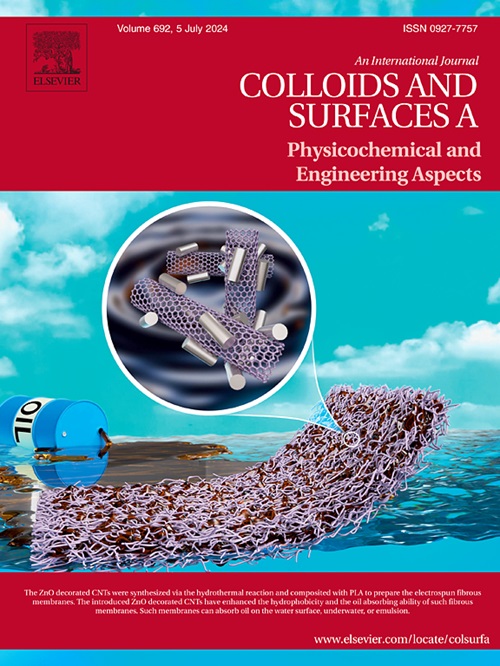Exploring the stability and binding interactions of insulin in chitosan/alginate nanohydrogels
IF 5.4
2区 化学
Q2 CHEMISTRY, PHYSICAL
Colloids and Surfaces A: Physicochemical and Engineering Aspects
Pub Date : 2025-07-17
DOI:10.1016/j.colsurfa.2025.137785
引用次数: 0
Abstract
Oral administration of insulin presents a desirable alternative to subcutaneous injection; however, achieving effective carrier-mediated protection of the peptide remains a significant challenge. In this study, we employed molecular dynamics (MD) simulations to investigate the encapsulation of insulin within three oral delivery systems at neutral pH: chitosan/alginate (CHI/ALG), deoxycholic acid-modified chitosan/alginate (CDA/ALG), and O-carboxymethyl chitosan/alginate (CMC/ALG). Building on previous experimental data, this work aimed to elucidate the atomic-level mechanisms governing insulin encapsulation. Previous MD studies have primarily focused on analyzing chitosan derivatives or isolated polysaccharides for insulin encapsulation; however, no prior research has directly compared multiple chitosan variants within a unified chitosan/alginate nanohydrogel system. Our results demonstrated that both CDA/ALG and CHI/ALG successfully encapsulated insulin, enhancing its structural stability. In contrast, the CMC/ALG system exhibited poor encapsulation performance, with insulin showing significantly less contact with the carrier and increased exposure to the surrounding environment, ultimately reducing its stability. In the effective systems, CDA and CHI formed stable nanoparticles around insulin, driven primarily by electrostatic, hydrophobic, and CH-π interactions. CDA, in particular, indicated greater residue-specific energy contributions, attributed to the self-assembly properties imparted by deoxycholic acid. Overall, CDA/ALG and CHI/ALG emerged as more promising candidates for oral insulin delivery. These findings provide valuable insights for the rational design of an environmentally friendly oral nanocarrier, with the potential to enhance insulin stability and bioavailability in the gastrointestinal tract.
探讨胰岛素在壳聚糖/海藻酸盐纳米水凝胶中的稳定性和结合相互作用
口服胰岛素是皮下注射的理想替代方案;然而,实现有效的载体介导的肽保护仍然是一个重大的挑战。在本研究中,我们采用分子动力学(MD)模拟研究了胰岛素在中性pH下三种口服给药系统中的包封:壳聚糖/海藻酸盐(CHI/ALG)、脱氧胆酸修饰壳聚糖/海藻酸盐(CDA/ALG)和o -羧甲基壳聚糖/海藻酸盐(CMC/ALG)。在先前实验数据的基础上,本研究旨在阐明胰岛素包封的原子水平机制。以往的医学研究主要集中在分析壳聚糖衍生物或分离多糖用于胰岛素包封;然而,在统一的壳聚糖/海藻酸盐纳米水凝胶体系中,没有研究直接比较多种壳聚糖变体。我们的研究结果表明CDA/ALG和CHI/ALG都成功地包裹了胰岛素,增强了胰岛素的结构稳定性。相比之下,CMC/ALG系统的包封性能较差,胰岛素与载体的接触明显减少,暴露于周围环境的时间增加,最终降低了其稳定性。在有效的系统中,CDA和CHI在胰岛素周围形成稳定的纳米颗粒,主要由静电、疏水和CH-π相互作用驱动。特别是,CDA表明,由于脱氧胆酸赋予的自组装特性,残基比能贡献更大。总的来说,CDA/ALG和CHI/ALG是口服胰岛素给药的更有希望的候选者。这些发现为合理设计一种环境友好的口服纳米载体提供了有价值的见解,具有提高胰岛素在胃肠道中的稳定性和生物利用度的潜力。
本文章由计算机程序翻译,如有差异,请以英文原文为准。
求助全文
约1分钟内获得全文
求助全文
来源期刊
CiteScore
8.70
自引率
9.60%
发文量
2421
审稿时长
56 days
期刊介绍:
Colloids and Surfaces A: Physicochemical and Engineering Aspects is an international journal devoted to the science underlying applications of colloids and interfacial phenomena.
The journal aims at publishing high quality research papers featuring new materials or new insights into the role of colloid and interface science in (for example) food, energy, minerals processing, pharmaceuticals or the environment.

 求助内容:
求助内容: 应助结果提醒方式:
应助结果提醒方式:


